Jade Leaf Organic Ceremonial Matcha (Barista Edition) Tests Positive for Lead, Cadmium, Mercury, and Arsenic: Lab Report Here
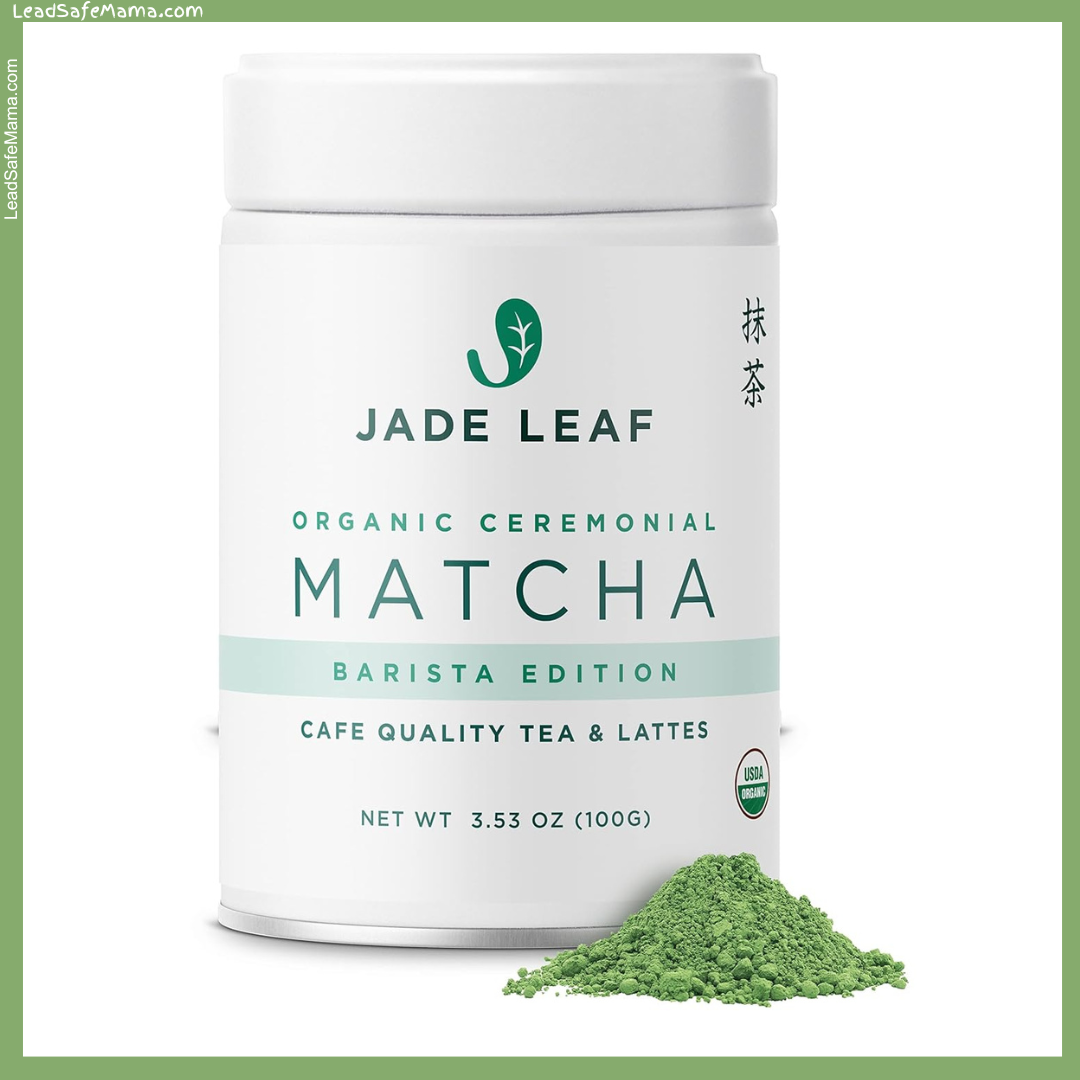
A Quick Note from Tamara Rubin:
The test results for this product are not at all surprising to me.
In the two decades that I have been conducting a “deep dive” into researching Lead-contamination of products, I have read multiple studies about the contamination of tea products — including matcha. Just ask my kids, I have ALWAYS told them never to consume anything with the word “Matcha” in the name (either as a flavor or a beverage). I am now extending that same advice to you (with the specific evidence presented through the test results of this product — see the lab report below). The key issue with matcha powder vs. normal brewed tea leaves is that you are consuming the actual ground tea leaves (not just the water the leaves have been steeped in), so the potential exposure is significantly greater than consuming other forms of green tea.
Interesting to note: In researching the heavy metals contamination of matcha (looking for the links shared above), most of the top hits were for pages on the websites of companies selling matcha products. To a letter, these companies have CYA statements stating “Prop 65” compliance and downplaying the concern for heavy metals in their product. So many sites actually claim their products are free of heavy metal contaminants, but they downplay the low threshold of detection of the testing they conduct (and the fact that their low threshold of detection is too high to determine or actually declare the product as “heavy metals free”). One example of this standard language designed to deflect blame can be seen below:
Our recommendation is that you may want to talk to your doctor if you have been consuming this product (or any other matcha products) on a regular basis. We recommend this regardless of the brand of matcha powder product you may be consuming. If you are curious about another specific brand or product, we do have some campaigns to raise funds for additional testing and reporting (linked here) on matcha and other matcha-flavored products to help demonstrate how this is not an issue isolated to this specific product or brand.
When you talk to your doctor, ask about what types of testing they offer. A heavy metals panel test (either blood or urine) may be warranted depending on your level of consumption. Provoked urine testing is not recommend for pregnant women, however if you are not pregnant you may want to ask your doctor about this option as it is more likely to show past/ ongoing /chronic exposure (blood testing for heavy metals only shows a recent snapshot of what is currently circulating in your body). You can read more about urine testing here.
“But Tamara, Japanese culture has been consuming this for centuries!”
It is important to remember that 500 or 600 years ago (when the practice of consuming tea in this way became popular), our planet did not have the pervasive agricultural contamination that we currently have. Things have changed, and until we can clean up the mess that has been created since the “industrial revolution,” we need to rethink which products we consume on a regular basis. There are safer choices out there (scroll down for the list of lab-tested safer choices that we have found through this initiative so far).
Additional Matcha Testing: If your matcha product is one of our laboratory testing campaigns that has not yet funded, please consider making a contribution so we can get that product sent off to the lab ASAP. If you don’t see a campaign for testing and reporting on your specific matcha product (at this link), you can nominate a specific product by following the instructions here.
The full lab report for this product is at the bottom of this article.
As far as safer choices for foods and supplements go, we have a few lists on our food and supplements testing landing page (linked here) that you may find helpful in making safer choices for your family. We even have one dedicated to safer snack choices here. You may also find this link helpful as it takes you to our most recently updated safer choices list of 42 lab-tested safer foods!
For those new to the Lead Safe Mama website:
Tamara Rubin is a multiple-federal-award-winning independent advocate for childhood Lead poisoning prevention and consumer goods safety, and a documentary filmmaker. She is also a mother of Lead-poisoned children (two of her four sons were acutely Lead-poisoned in 2005).
- Tamara owns and runs Lead Safe Mama, LLC — a unique community collaborative woman-owned small business for childhood Lead poisoning prevention and consumer goods safety.
- Since July 2022, the work of Lead Safe Mama, LLC has been responsible for six product recalls (FDA and CPSC).
- All test results reported on this website are science-based, accurate, and replicable.
- Please check out our press page to see some of the news coverage of our work, linked here.
This is an ad-free article.
Advertising and affiliate income help Lead Safe Mama, LLC cover the costs of the work we do here (independent consumer goods testing and childhood Lead poisoning prevention advocacy). We have removed ads from most of our more widely-read articles (and newly published articles, too — like this one!) to make them easier for you to read. In addition to supporting this work by starting any shopping you might be doing with a click on our affiliate links, if you would like to support the independent consumer goods testing and childhood Lead poisoning prevention advocacy work of Lead Safe Mama, LLC by making a contribution (which will also help us keep our more widely-read articles ad-free), click here. Thank you!
Important Background: What is an Action Level?
Please note the following key points:
The original lab report for this product is below (at the bottom of this page).
The graphic above shows the levels of metals detected in this product (in red) along with the low threshold of detection (in orange, above the action levels discussed/ or in green, below the action levels discussed) for each metal not detected with the laboratory testing Lead Safe Mama, LLC had completed for this product. The numbers are juxtaposed (in blue) to the “Action Level” proposed by the medical and scientific community in 2021 as part of the Baby Food Safety Act.
- These 2021 levels were proposed as “Action Levels” because they are (in fact) protective of human health.
- An “Action Level” is NOT the same as a “Maximum Allowable Level” or a “Recommended Daily Amount.” If a product reaches the “Action Level” for heavy metals, it has too much of the heavy metals in question.
- Many food and supplement manufacturers misinterpret existing guidance on heavy metals to mean the stated levels are “allowable levels” or “acceptable levels” (in spite of the scientific consensus that there is no safe level of Lead exposure, for example) and consider it reasonable for products to test positive for heavy metals, but at levels that fall below any regulated maximums.
- This is a (perhaps intentional?) misunderstanding/ misinterpretation the food and supplement industry makes — a misunderstanding food manufacturers use to justify the presence of heavy metals in products.
- As an example: A common refrain in this realm is when a supplement or food manufacturer proudly proclaims its product meets prop 65 guidelines as it tests positive for Lead, but under the limit noted by Prop 65. This position entirely disregards the well-known scientific fact that there is no safe level of Lead exposure for humans.
- Heavy metals accumulate in the body.
- It is the cumulative/ aggregate impact of heavy metal exposure (over a lifetime) that makes even small/ incidental/ seemingly trivial exposures particularly damaging and dangerous. You can read more about that here.
- Once a food or supplement product has the amount of heavy metal (Lead, Cadmium, Mercury, or Arsenic) noted (above) as the “Action Level,” that product is officially considered (by the scientific and medical community) to have metals at a level that is unsafe for consumption by children — as toxicants (found at-or-above these levels) are in the range of heavy metal levels that have been demonstrated to cause lasting harm.
- Action Levels are a better (more health-protective) metric than Prop 65 limits as they are more comprehensive and UNRELATED TO SERVING SIZE .
- Serving sizes are set by manufacturers and in many cases do not reflect real world consumption habits and patterns (more on that below).
- Serving size thresholds for toxicity also do not take into account realistic levels of toxicant ingestion from multiple foods and supplements over the course of a given day — or week or month (especially given the fact that many products are typically consumed in quantities far greater than a manufacturer-set serving size).
- Serving sizes are often set to quantities that are intentionally lower than anticipated actually daily consumption of a product (see bag of potato chips example below) — companies specifically set these lower quantities only in order to be in compliance with Prop 65 (or other serving-size-related) standards.
- On the other hand, Action Levels are relevant for any amount of a food or supplement product that may be consumed (any quantity of the food or supplement in question).
- Action Levels are a better (more health-protective) measure as they take into account the total heavy metals content of all products consumed throughout the day (were there to be a federally-mandated, health protective Action Level for all ingested items).
- If the Action Level for all items is protective of children’s health, one would never need to have any attention on how much of a product a child was consuming.
- Action levels are a more reasonable metric in light of the fact that all federal agencies agree there is no safe level of Lead exposure (especially for children, but truly for all humans).
- If we are evaluating Lead exposure based on serving size, we are contradicting science by asserting that a certain amount of Lead is ok (within arbitrary limits that, again, are not protective of human health).
- PPB (parts per billion/ ppb) measurements are a percentage (albeit a very small percentage) and apply to any quantity of any food or supplement product (tested or ingested).
- If all ingested foods and supplements were evaluated by ppb content for heavy metals across the board (using the same scale for all types of ingested products), confusion over safety limits would be eliminated.
- By retaining a structure of serving-size-based exposure our regulatory agencies are doing a disservice to consumers — again (especially) as all federal agencies (and scientists and medical experts) agree there is no safe level of Lead exposure.
- For more discussion about serving size considerations (and why relying on “serving size” to limit toxicant exposure is not a relevant metric/ not a metric protective of human health), read this article.
- These “Action Levels” proposed in 2021 are the levels at which the scientific and medical community believe the manufacturer (or government) needs to take ACTION to fix the problem.
- One “Action” would be for the manufacturer to take steps to reduce the levels of toxicants in the food or supplement product.
- Another “Action” would be for the manufacturer to cease sales of the product until the product could be made safe.
- Another “Action” would be for the manufacturer to inform the public that a specific food or supplement product has an unsafe level of the metal detected at-or-above the “Action Level” — making a highly-visible public announcement regarding which relevant batches of the product should be recalled/ no longer consumed.
- The Action Levels proposed with the Baby Food Safety Act of 2021 were not arbitrary toxicant levels, but were proposed because they are the levels most protective of human health. However, the Baby Food Safety Act of 2021 was not passed into law.
- Regardless of the fact the Baby Food Safety Act of 2021 never passed into law — and it is therefore legal to have foods and supplements marketed for consumption by children test positive for Lead, Cadmium, Mercury, and Arsenic at-or-above these levels — these Action Levels still reflect the current (modern/ relevant) advice of the medical and scientific communities as levels both achievable by the industry and safeguards of infant and toddler health.
- Food and supplement industry lobbyists fought against formalizing these proposed “Action Levels” as a government standard, alleging the levels were unachievable.
- The list of safer choices (below) clearly demonstrate these Action Levels as achievable across a range of food and supplement types (vitamins, salt, flour, coffee, oatmeal, chia seeds, hemp seeds, soy milk, packaged fruit-based snacks, beverages, and more).
- The legitimacy of these levels as “Action Levels”/ “Levels of Concern” (even though they were not adopted as law) is mirrored by the legitimacy of the American Academy of Pediatrics’ level of concern for Lead in water, which is 1 ppb despite the FDA’s official “level of concern” for Lead in water being 15 ppb (you can read more about that here).
“Simply Not Achievable”
To reiterate: While the packaged, processed food industry would have consumers (and the government) believe the standards proposed in 2021 are unachievable, this industry position (an oft-rearticulated response to nearly every set of laboratory test results for food and supplements that we have published to date) is simply not true.
It is possible to make safer processed, packaged food products and supplements that fall well below the safety limits for toxicants proposed within the Baby Food Safety Act of 2021. To wit, the products listed below (the first section of the list below) tested “non-detect” for Lead, Cadmium, Mercury, and Arsenic — several even tested non-detect for Lead with the low threshold of detection being “less than 1.5 ppb.”
Are you interested in seeing MORE safer choices?
Below is an expanding list of products (foods, supplements, cosmetics, and personal care items) that tested “non-detect” for Lead, Mercury, Cadmium, and Arsenic with independent, third-party, community-funded laboratory testing coordinated by Lead Safe Mama, LLC (an Oregon-based small business with a unique community-collaborative business model and a focus on consumer goods safety and childhood Lead poisoning prevention). The product examples below clearly demonstrate that companies can manufacture safer choices (at least from the perspective of a concern for heavy metals contamination).
–
The limits of detection (low-threshold of detection) for each of the metals tested are noted in the lab report for the specific product listed. To see the full original lab report for any of these products, type the brand name into the search bar at the top of any page on Lead Safe Mama dot com (and scroll down to the bottom of the related article). All our published lab reports are also linked here, on our lab testing landing page.
–
Flavors (or specific variations) tested are noted, and other flavors of the same product (or other products from the same brand) have either not been tested or have been tested but did not yield similar results. Test results only apply to the specific products linked below.
Products on our “safer choices” list are retested periodically (annually or more frequently, as funding permits). If a product no longer tests clean, it is removed from the list.
LIST UPDATED — June 4, 2025
Now at 68 products + 6 “bonus” options. Scroll down to see all 74 Lab-tested Safer Choices:
- Baby Food — 1 — Little Spoon Kale, Carrot + Pear BabyBlends
- Baby Food — 2 —Little Spoon Butternut Squash + Blueberry BabyBlends
- Baby Food — 3 — Little Spoon Sweet Potato BabyBlends
- Baby Food — 4 — Little Spoon Sweet Potato + Carrot BabyBlends
- Baby Food — 5 — Little Spoon Banana + Pitaya BabyBlends
- Beverage — 1 — Honest Kids Organic Appley Ever After Apple Juice Drink: https://amzn.to/4fjGhov
- Beverage — 2 — Olipop Grape Tonic: https://amzn.to/4cjFYZu
- Breakfast Cereal — 1 — Nature’s Path Envirokidz Organic Panda Puffs: https://amzn.to/4fo1crf
- Breakfast Cereal — 2 — Nature’s Path Envirokidz Organic Corn Puffs Gorilla Munch: https://amzn.to/3FHZCDO
- Candy — 1 — Cavendish & Harvey Wild Berry Drops, not organic (Germany): https://amzn.to/3Z1Jxjr
- NEW! Candy — 2 — Haribo Gummy Bears** (Made in Germany, Not USA Produced): https://amzn.to/3FCGVlu
- Candy — 3 — Lindt White Chocolate Bar (Made in USA, New Hampshire): https://amzn.to/3OXkyIm
- Coffee & Tea — 1 — Chameleon Handcrafted Organic Cold Brew Concentrate: https://amzn.to/3OcrH77
- Coffee & Tea — 2 —Tao of Tea Organic Genmaicha (Tamara’s favorite, from Japan, sold by a Portland, Oregon-based company!): https://amzn.to/3Dp8Fsd
- Coffee & Tea — 3 — Califia Farms Almond Latte Cold Brew (XX Espresso): https://amzn.to/4gTTGoJ
- Coffee & Tea — 4 — Death Wish Organic Espresso Roast Ground Coffee (Multi-country origin, non-USA): https://amzn.to/3yo1eiL
- Cosmetic— 1 — Babo Botanicals Sensitive Baby Lotion: https://amzn.to/3YmKxy1
- Cosmetic — 2 — Kora Organics Noni Face Oil: https://amzn.to/43hy2XO
- Dairy — 1 — (cheese) — Babybel Mini Original Snack Cheese: https://amzn.to/3ZY5noO
- Dairy — 2 — (coffee creamer) — Organic Valley Grassmilk Half and Half: https://amzn.to/4fHJIWT
- Fruit Snack — 1 — (bar) — Pure Organic Layered Fruit Bars in Raspberry Lemonade Flavor: https://amzn.to/3XcFsIp
- Fruit Snack — 2 — (bar) —Pure Organic Layered Fruit Bars in Strawberry Banana Flavor: https://amzn.to/3WQEekA
- Fruit Snack — 3 — (pouch) — Costco’s Kirkland Organic Apple Sauce Pouch: https://amzn.to/4gOYpZ9
- Fruit Snack — 4 — (pouch) — GoGo Squeez Organic Apple Sauce Pouch: https://amzn.to/3XhWYLe
- Fruit Snack — 5 — (pouch) — Once Upon A Farm Dairy Free Fruit Smoothie Pouch in Strawberry Banana Swirl Flavor: https://amzn.to/3CPMbAw
- Infant Formula — 1 — Bobbie Organic Gentle Infant Formula Milk-Based Powder with Iron (pink and white can): https://amzn.to/3YYb849
- Infant Formula — 2 — Bobbie Organic Infant Formula Milk-Based Powder with Iron (green and white can): https://amzn.to/3VOr4Vy
- Infant Formula — 3 — Bobbie Grass-Fed Milk-Based Powder with Iron (green can): https://amzn.to/3ZlAaeJ
- Infant Formula — 4 — ByHeart Infant Formula (USA-made, not organic): https://amzn.to/48DJjTb
- Infant Formula — 5 — HiPP Bio Combiotik Infant Formula Powder, Stage 1 (imported)
- Infant Formula — 6 — HiPP HA Stage PRE (0+ Months) Combiotic Formula (imported)
- Infant Formula — 7 — Holle Bio Goat Stage 2 Infant Formula (for 6-10 months, organic, European — Swiss/ German/ Austrian) is not available on Amazon, but the Stage 3 version of this product is (not yet tested, but will likely test similarly): https://amzn.to/3BVU7zI
- Infant Formula — 8 — Kendamil Goat Infant Formula (not organic): This product may be available at Target (it is not available on Amazon)
- Infant Formula — 9 — Kendamil Organic Follow-On Milk (European/ British Toddler Formula, for 6-12 months, Cow Milk): Not available on Amazon
- Infant Formula — 10 — Kendamil Whole Milk Infant Formula (from Europe, pink can, not organic), available at Target
- Infant Formula — 11 — Kendamil Organic Infant Formula (Cow Milk): Not available on Amazon but may be available at Target
- Ingredient — 1 — (baking flour) — Jovial Organic Einkorn Flour (Italy): https://amzn.to/3LIqxix
- Ingredient — 2 — (beans) — Jovial Organic Chickpeas, Product of Italy: https://amzn.to/4iRON1l
- Ingredient — 3 — (vinegar) — Napa Valley Naturals Organic Red Wine Vinegar (California): https://amzn.to/4jWhHOg
- Oil — 1 — (avocado) — Chosen Foods 100% Avocado Oil (not organic): https://amzn.to/3YDZSuv
- Oil — 2 — (coconut) — Dr. Bronner’s Regenerative Organic Coconut Oil: https://amzn.to/40xwBmv
- NEW! Oil — 3 — (olive) — Bryan Johnson BluePrint Snake Oil Olive Oil** (not organic): https://amzn.to/4mMieUj
- Oil — 4 — (perilla seed) — Dr. Adorable’s Organic Perilla Seed Oil (Korea): https://amzn.to/3NDt7Yc
- Plant-Based Milk — 1 — (coffee creamer) — Laird Superfood Coconut Creamer: https://amzn.to/4fItA7A
- Plant-Based Milk — 2 — (plant milk) — Kiki Milk Organic Plant-Based Milk (original flavor): https://amzn.to/3AA6Qrt
- Plant-Based Milk — 3 — (soy milk) — West Soy Unflavored Unsweetened Organic Soy Milk: https://amzn.to/4dwev8l
- Salt — 1 — Jacobsen’s Sea Salt (Oregon, USA): https://amzn.to/4dcbk5L
- NEW! Salt — 2 —Maldon Sea Salt Flakes**: https://amzn.to/4iTzWTE
- NEW! Salt — 3 — Diamond Crystal Kosher Salt** : https://amzn.to/4cVQMiy
- Seeds — 1 — (chia) —Navitas Organic, Gluten-Free Chia Seeds (Mexico): https://amzn.to/3YvE7xC
- Seeds — 2 — (hemp) — Costco Kirkland Organic Hemp Seeds: https://amzn.to/4e05RP9
- Supplement — 1 — (adult) — Doctor’s Best Vitamin C with Q-C: https://amzn.to/4hlVvea
- Supplement — 2 — (adult) —Nordic Naturals Omega-3 Fish Oil: https://amzn.to/48q1j2V
- Supplement — 3 — (adult) — Pectasol Modified Citrus Pectin, Formulated in the USA: https://amzn.to/3QUmZfN
- Supplement — 4 — (adult) — Pendulum Metabolic Daily Dietary Supplement: https://amzn.to/4gY5wOm
- Supplement — 5 — (kids) —Baby Ddrops, Organic Vitamin D3 Supplement for Babies: https://amzn.to/49C3ktH
- Supplement — 6 — (kids) — Mary Ruth’s Organic Toddler Multivitamin Liquid Drops with Iron: https://amzn.to/3YPhcgx
- Supplement — 7 — (kids) —Mary Ruth’s Organic Toddler Elderberry Liquid Drops: https://amzn.to/42617TU
- Supplement — 8 — (kids) — Nordic Naturals Kids Vitamin D3 Gummies (Ages 3+): https://amzn.to/4l7117a
- Sweetener — 1 — (sugar) — Anthony’s Organic Granulated Cane Sugar: https://amzn.to/4jf6vLv
- Sweetener — 2— (xylitol) — Espure Organic Xylitol: https://amzn.to/3GsCSrU
- Sweetener — 3— (xylitol) —Now Real Food Granulated Xylitol: https://amzn.to/4cNWDpM
- Toothpaste — 1 — Fluoride-free Orajel Kids Training Toothpaste in Natural Berry Fruity Flavor with Elmo Sesame Street Packaging: https://amzn.to/41wxtrY
- Toothpaste — 2 — Fluoride-free Miessence Mint Toothpaste: https://amzn.to/4bJc4PO
- Toothpaste — 3 — Dr. Brown’s Fluoride-free Baby Toothpaste in Strawberry Flavor: https://amzn.to/3DCehzZ
- Toothpaste — 4 — Pegciz Kids Foam Toothpaste in Watermelon Flavor, Low Flouride (packaging varies, see report): https://amzn.to/3YzP68e
- Toothpaste — 5 — Kid’s Spry Fluoride-free Tooth Gel with Xylitol in Original Flavor: https://amzn.to/41GZb4e
- Toothpaste — 6 — Fluoride-free Essential Oxygen BR Certified Organic in Peppermint Flavor: https://amzn.to/4lARZ2J
**Lab reports pending/ Not yet published as of 6/4/2025
Here’s a link to our landing page featuring all the third-party lab reports for the foods, supplements, and cosmetic products we have published to date, including those listed above: https://tamararubin.com/2024/05/food-articles/
Stand by for more!
BONUS: Below are SIX additional products that each tested positive for trace (very low levels of) Arsenic — at levels considered safe by all standards (with the limits of detection noted in the lab report for the specific product listed).
- Infant Formula — Kendamil Goat Toddler Milk, not organic (positive for traces of Arsenic): May be available at Target or through other online retailers of European infant formulas
- Ingredient — Maseca Instant Corn Masa Flour, Product of Mexico (positive for traces of Arsenic): https://amzn.to/4iR8qWN
- Fruit Snack — That’s It Apple Cherry Bars, not organic (positive for traces of Arsenic): https://amzn.to/4fHkSWV
- Oil — Chosen Foods 100% Pure Avocado oil, organic (postive for traces of Arsenic): https://amzn.to/3BVQYQa
- Supplement — (adult) — Now Sunflower Lecithin, not organic (positive for traces of Arsenic): https://amzn.to/3AFdHzO
- Supplement — (adult) — WishGarden Immune Boost Seasonal Rescue for Pregnancy: https://amzn.to/3Cd940N
Amazon links are affiliate links.
Published: January 01, 2025
Wednesday
Please scroll down to see the full laboratory test report for the product pictured above. Thank you.
More Key Points To Consider:
- There are almost no reasonable safety limits proposed for toxicant contamination (heavy metal contamination specifically) of foods and supplements consumed by adults (or by the general population) in the United States.
- Any available proposed safety thresholds (and guidance) for foods and supplements consumed by adults are not currently set at levels that are protective of human health, given practical/ actual consumption patterns of foods (vs. manufacturer defined serving sizes).
- The above point is especially important given children eat all foods, not just foods marketed for consumption by children (for example: Find me a pre-teen that won’t go through an entire 5-ounce/ 5-serving bag of potato chips in one sitting)!
- Our focus is (as always) on the health of children.
- By applying the standards proposed by the Baby Food Safety Act of 2021 to all foods and supplements , we are working more in-line with standards that are protective of human health (for all!) given that all scientific and medical experts agree there is no safe level of Lead exposure for human beings.
- Said another way: You would never be eating a snack chip out of a bag and say to your 5-year-old child “this product is only marketed for consumption by adults, so you cannot eat it.” That would be ridiculous. Kids eat what we eat, so everything that goes into our bodies in an attempt to nourish us and support our health and well being should be appropriate for any age consumer (not just a demographic designated by the manufacturer based on irrelevant age-group related toxicity standards for a specific product or ingredient).
- Remember: There is no safe level of Lead exposure for human beings. Period.
- This is a non-negotiable point that everyone in the scientific and medical community — everyone who researches Lead poisoning — agrees with.
This is the Lead Safe Mama Amazon affiliate link to purchase a test kit similar to what we use for our laboratory testing.
To see more articles related to the laboratory testing of foods and supplements Lead Safe Mama, LLC is conducting (including background on this initiative and safer food choices and guidelines), click the pink square below. To see the full, independent, third-party laboratory report for the product pictured above, please scroll down to the bottom of this page.
Amazon links are affiliate links. If you purchase something after clicking on a Lead Safe Mama, LLC Amazon affiliate link, Lead Safe Mama, LLC may receive a percentage of what you spend at no extra cost to you.
Lab report for the product pictured above:
Never Miss an Important Article Again!
Join our Email List





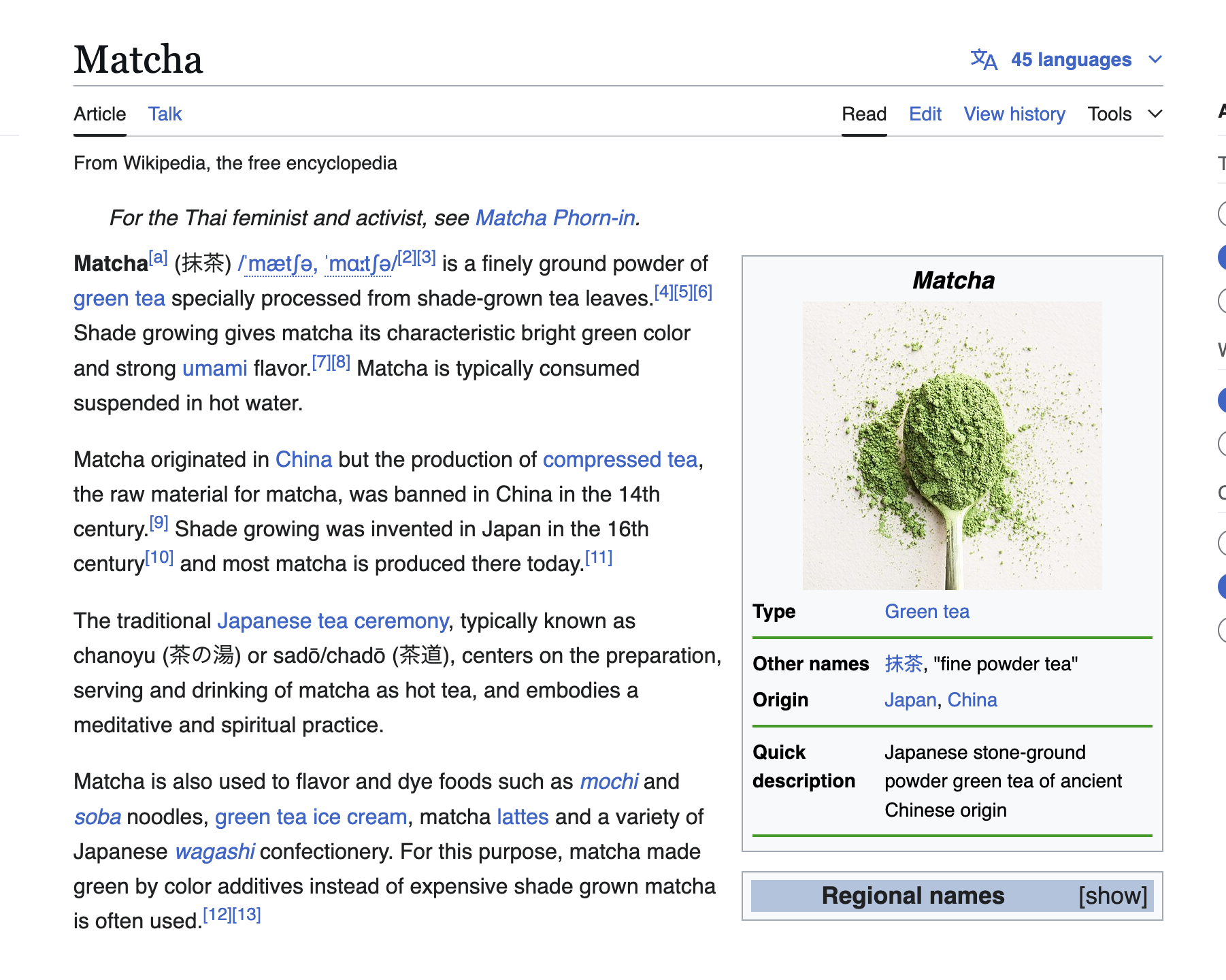
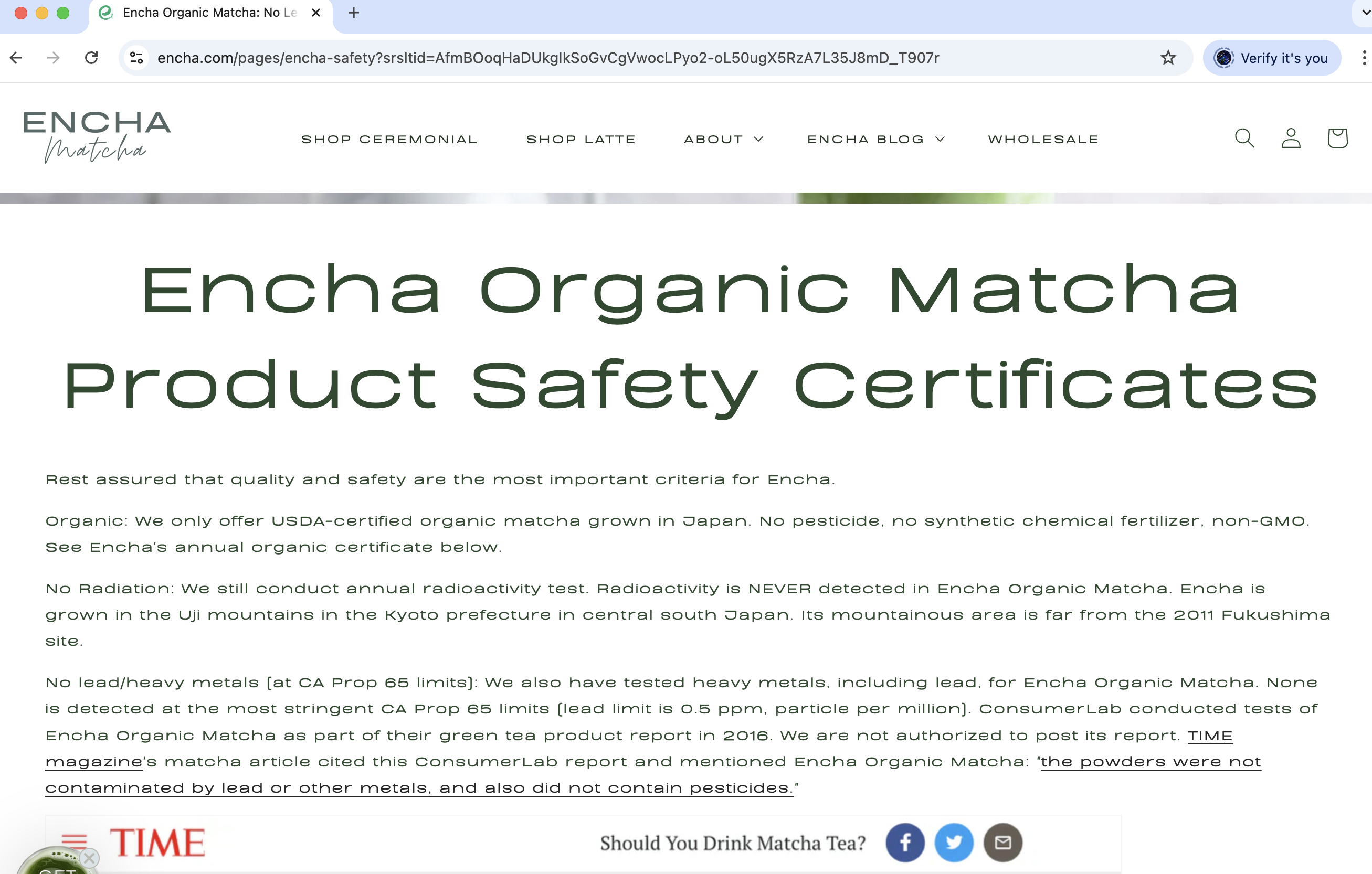
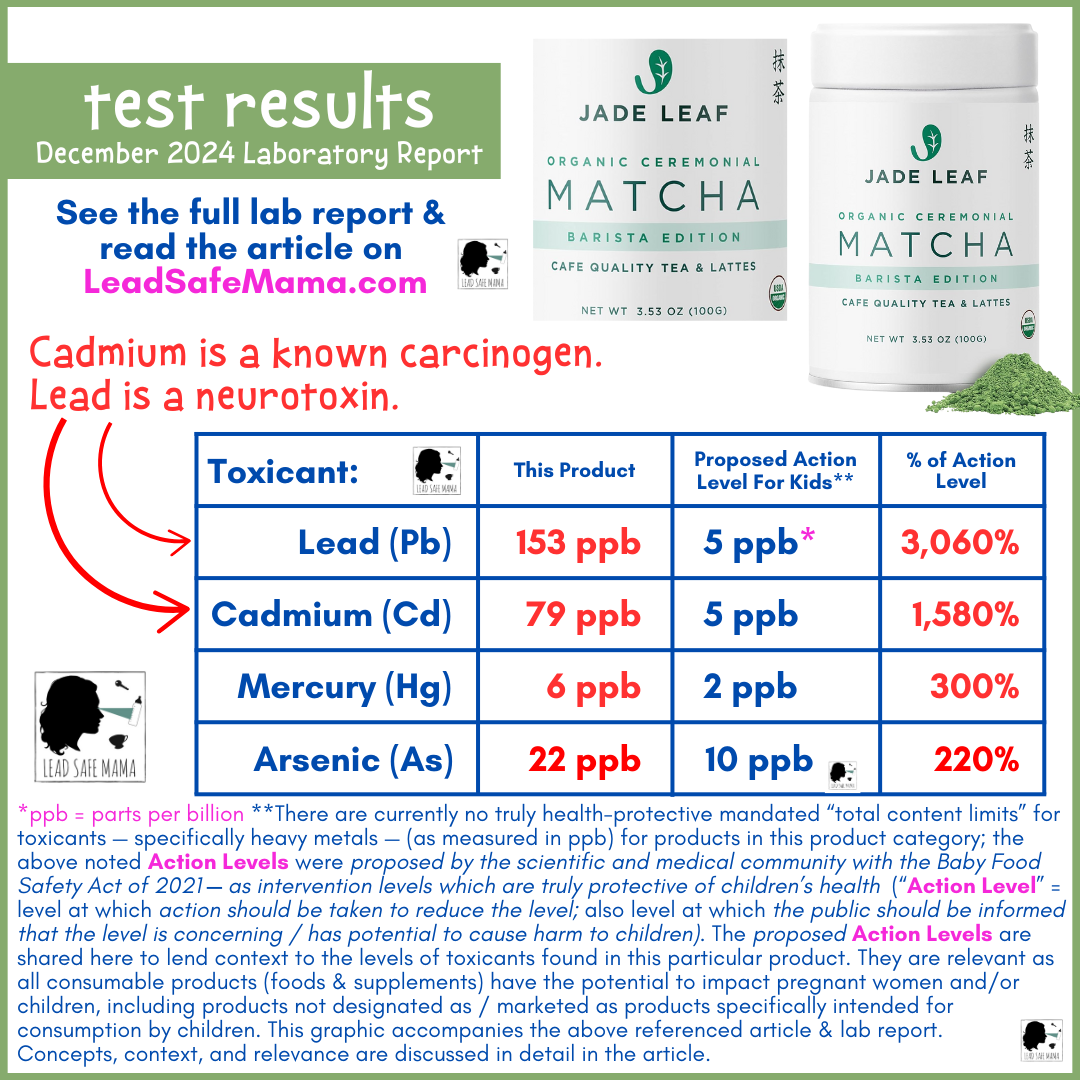

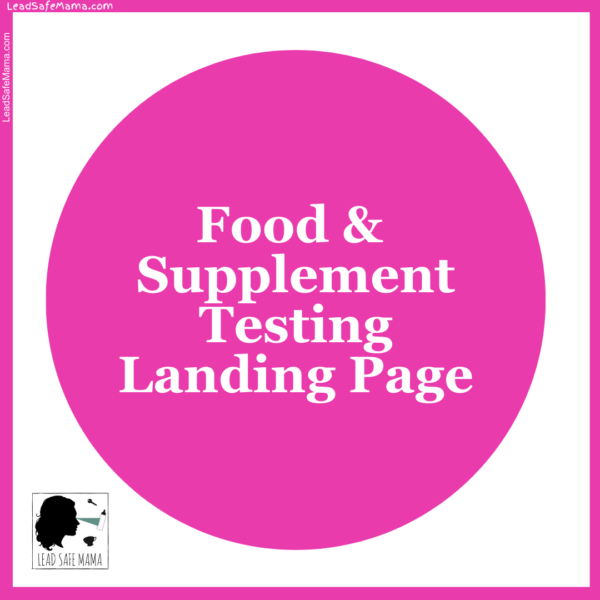
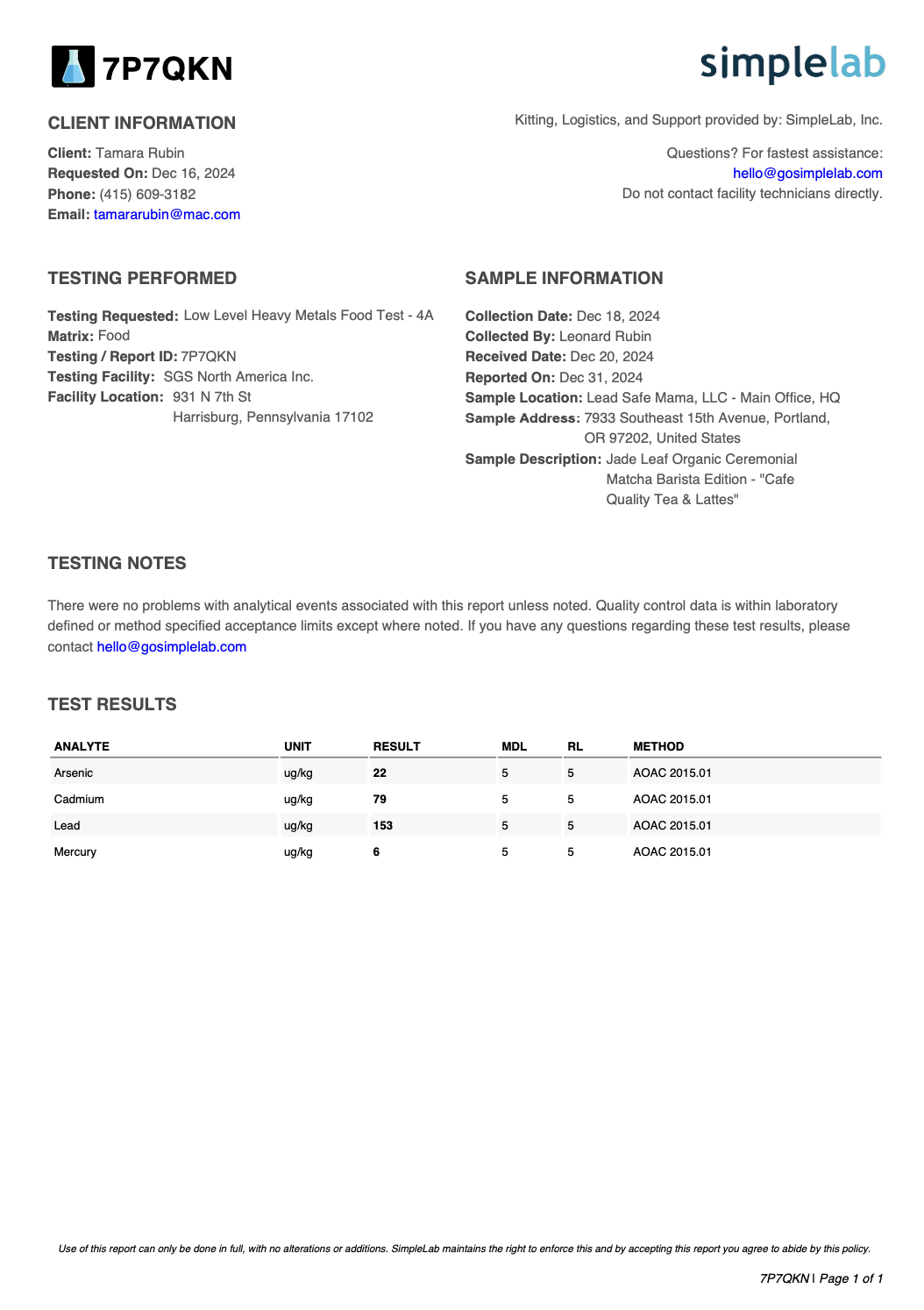

Well this is disappointing but I think on some level I did wonder what was hiding in my own matcha (which is a different brand). I’ve been making myself a matcha almost daily for a few years now, so that’s probably not great.
Interestingly I did see my matcha and also this matcha tested by Consumerlab a while ago (then updated this year) and both ‘passed’ and were ‘approved’ even though it was acknowledged they did have detectable lead (though weirdly, both of the whole-leaf matchas had less lead than many of the brewable teas). They also tested for cadmium, arsenic, and mercury. They used prop 65 levels in their assessment.
I also went back to good old Nutritionfacts.org for the videos/transcripts on matcha and he emphasizes being careful about country of origin when consuming green tea or matcha (avoid China, basically), but if you’re a healthy adult and consuming matcha from Japan, then you can ‘safely eat 15 spoonfuls a day.’ Now this is from 2015, but he also references the prop 65 guidelines. This seems like a lot, but he mentions some people use matcha in smoothies, apparently.
One question I have about the above article is that, if we’ve been consuming matcha regularly, it’s suggested we contact our healthcare provider about getting tested. I’m just curious: to what end? Getting a blood lead test in Canada has cost me $150-200 each time (depending on the lab), whether going through a doctor or naturopath, and I could only get traction with my naturopath. In my experience, and talking to other Canadians, doctors here literally say ‘we don’t test blood lead unless an it’s for, say, a kid who has eaten a handful of lead paint chips.’
So, other than confirming elevated lead levels, will the treatment change? It seems chelation is pretty much to be avoided, even in cases where blood lead is extremely high (my niece was extremely high when she was adopted from China at the age of 1, but the doctors were still reluctant to use chelation) so really the only route seems to be getting rid of the lead contributor/s, and using fibre, vitamin c, and garlic. So I guess I’m just wondering about the direction to get tested.
Thank you.
Personally – if I hade been consuming something like this, I would be curious about the potential range of exposure. There’s also potential evidence to be gained if one is having health impacts and wants to pursue restitution from the company (not an easy thing to do, but in some cases that may be warranted).
Having a clean heavy metal panel test is just as valuable as having one that shows you have exposure concerns. Have you seen the video and report for the urine testing panel I did? If not, that might be interesting for you to check out:
Video One (a bit of sillyness!):
https://tamararubin.com/2022/06/tamara-gets-a-provoked-urine-test-for-lead-other-metals-in-new-york-city-video/
Report:
https://tamararubin.com/2022/06/would-you-like-to-see-my-personal-full-heavy-metals-test-results-here-you-go/
Audio Recording of Conversation with the Doctor:
https://tamararubin.com/2022/10/dr-john-salerno-tamara-len-rubin-discuss-tamaras-heavy-metal-test-results-audio-recording/
Thank you, Tamara, I did see those videos and reports—very useful information—thank you.
(And I meant to come back on here tonight to clarify in my post that the fibre, vitamin c, and garlic should come from regular old food—plants—not supplements. I think that’s important and shouldn’t have left it out. )
I agree, it can definitely be informative to have a panel done. I (and my husband and son) did actually have a full heavy metal hair test done 1.5 years ago (when I was already into my matcha drinking) and the main things that tested high for us all were lead and copper. Just for a trip down memory lane…the reason I got the tests done was because we were using a set of Mikasa plates we got at the local ReUseIt (I’ve since thrown them in the garbage) and something I read about menopause and heavy metals made me suspicious about those plates (‘china’), so I searched them and found you and your work, and confirmed many Mikasa (like our older ones) test high. Once we tossed the plates, the lead came down step-wise in subsequent tests.
(Interestingly, the copper remained a mystery. We tested our water, etc, all the usual suspects. But now, I’m actually wondering about the organic food (plants)we’ve eaten (as exclusively as we can) for the past decade plus, as the more I look into the pesticides used on organic produce, the more I’m coming to wonder about the use of copper sulphate (an approved organic pesticide), which would appear to bioaccumulate fairly readily, and often has to be used in relatively high doses to be as effective as non-organic pesticides, which, of course, have their own issues. So that’s something I’m pondering right now, and we’re experimenting with being less strict in terms of buying organic, though it feels scary.)
So now I just have to decide what I’m gonna do!
If you happen to have made it this far, Id like to mention a couple more things. First, I’m sorry your family has had that scare with the polyps you mentioned in a recent post. I can’t imagine anyone better than you to have on the case with an issue like that, but I’m sorry it has to be you.
And also, I just wanted to say I really appreciate the tone in the most recent testing/write-ups you’ve been doing. I’m not sure if it’s you personally writing all the writeups, but the most recent ones have been more informing us of what you would/are going to do for your own family, and ‘leaving the ball in our court/s’ with some suggestions. I find this is far less alarming (for maybe only myself???) but this softening of tone is really appreciated, given that the whole idea of heavy metals in our foods is just so alarming for all of us (and of course, we all react to that alarm in different ways, including by lashing out).
You’re appreciated.
I really hate this but I am glad to know its not safe, Do you think brewed coffee would be similar?
Well that sucks, I guess I’m cancelling my Encha Matcha for now. Despite advertising “safe” lead/ heavy metals , arsenic, it’s hard to trust anymore.
Any plans for testing Paleo Valleys new coffee and Electrolytes?
We don’t have any pending testing for that brand. Here’s how to nominate something for testing:
https://tamararubin.com/nominate/
Sad to give up the matcha, but even sadder that the 2 brands I trusted when they told me they were under prop 65 guidelines or “non-detect”, are this high. I had my lead and cadmium levels tested this past fall (via bkood test, but it only told me I was below 1 ppm. Is there a version that tests lower than that? Thanks!
You might want to consider getting a urine test (provoked 24-hour urine) – more on that here (ask your doctor!):
https://tamararubin.com/2020/05/i-heard-that-urine-and-hair-tests-for-heavy-metals-including-lead-were-not-real-or-useful-test-results-why-is-this/
Are there any alternative brands that are safe? I may have missed this. If so, can you link a safe matcha?
Should I then avoid all Jade Leaf Matcha? I’ve been using this product for more than two years. Maximum intake about a teaspoon a day. I don’t use the ceremonial one. I use the one for beverages and cooking. I’m very weary now particularly because I have two large bags of it in my cupboard that were supposed to last me for the rest of the year. Have you found safer brands? At this point I’m thinking I should try growing my own plants to make my own matcha powder. If you find alternatives please I’d be so grateful if you made a post. Thank you so much.
Encha was thought to be “clean” as well, but turned out like Jade Leaf. I think Pique is our greatest hope. It’s expensive though (like $1 a serving), but is one with a GoFundMe to tests we can find out.
In the article, you stated to “never consume anything with matcha”. Are you suggesting that all Matcha’s on the planet are high in heavy metals?
Currently in 2025 – that appears to be correct, yes (when consumed as a powder, vs. steeped green tea).
Just today, 5/20/2025, Consumer Lab addressed this and put up an assay for Jade Leaf , saying the tea is fine. Those with a subscription to CL could check details and decide for himself/herself.
There’s no safe level of lead exposure. Consumer Labs does not use current accepted science.
T